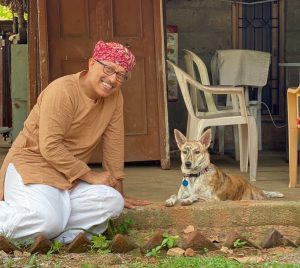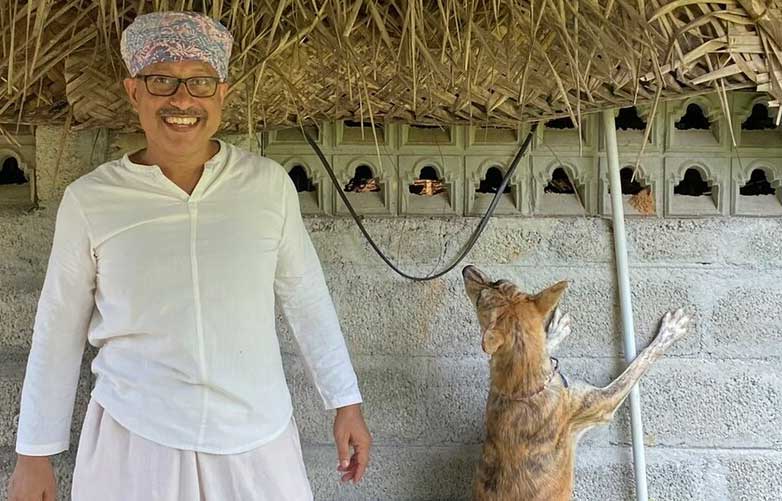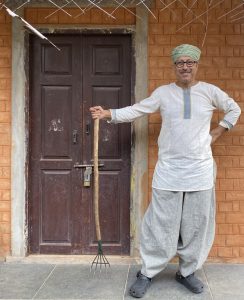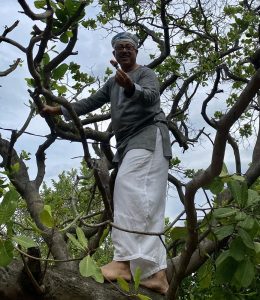I have not worn anything other than handloom clothings for the last 20 years or perhaps even more. Except for rare occasions when we need some extra cover for extraordinarily low temperatures.

I started wearing handloom clothings for sheer comfort, then for its look and texture. However, when I started going deeper into the origin of handloom clothings, I realised the deepened stories of historical significance, geographical uniqueness, human innovation and perseverance, scientific wisdom, and stories of blood, sweat, poverty, beauty, and mathematics. At the end, when I wear a handloom or a product of an artisan, and if I am doing it consciously, I have a story to tell behind each of the beauty that I carry on by body.
 My emotional connect to handloom and the artisans is not based on a tourist visiting a handloom cluster, but more than 20 years of journey to the handloom clusters of weavers, artisans, and communities of craft wo(men) with hands and minds across Madhya Pradesh (Chanderi, Shivpuri), Uttar Pradesh (Barabanki, Moradabad, Ghazipur, Lucknow, Bhadoi, Sultanpur, Varanasi, Kanpur, Muzaffarnagar, et al), Bihar (Bhagalpur, Darbhanga, Muzaffarpur, Vaishali), Jharkhand (Deoghar, Ranchi, etc), West Bengal (Kalimpong, Murshidabad), Punjab (Amritsar), Himachal Pradesh (Jwalaji, Palampur, McLeodganj, etc.), Maharashtra (Aurangabad, Palghar, Gadhchiroli, Nagpur, Mumbai), Assam, Meghalaya (Kohima, West Garo Hills), Nagaland (Kohima), Arunachal Pradesh (Apatani Tribes in Ziro), Kashmir, Sikkim, Tamil Nadu (Kanchipuram, Musiri, Sivaganga, Trichy, Chidambaram, Tirunelveli, Sittilingi, Villupuram, etc.), Pondicherry, Kerala, Telangana (Choutuppal, Pochampally, Hyderabad, Mehboobnagar), Odisha (Bhubaneshwar, Cuttack, Bargarh, Nuapatna, Pipli, Mayurbhanj), Andhra Pradesh (Anantapur, Chirala, Vizag, Nalgonda), Karnataka (Kollegal, Mysuru, Madikeri, etc), Uttarakhand (Garhwal and Kumaon), Goa, Gujarat (Kutch, Ahmedabad, Baroda), Chhattisgarh, Haryana (Nuh, Hissar), Rajasthan (Alwar, Jaipur, Jodhpur, Jaisalmer, Barmer, Kishangarh, Ajmer, Pali, Bikaner, Kota, Bharatpur, Udaipur, Churi, Jhunjhunu, Sikar, Baran, Sirohi, Rajsamand, etc.).
My emotional connect to handloom and the artisans is not based on a tourist visiting a handloom cluster, but more than 20 years of journey to the handloom clusters of weavers, artisans, and communities of craft wo(men) with hands and minds across Madhya Pradesh (Chanderi, Shivpuri), Uttar Pradesh (Barabanki, Moradabad, Ghazipur, Lucknow, Bhadoi, Sultanpur, Varanasi, Kanpur, Muzaffarnagar, et al), Bihar (Bhagalpur, Darbhanga, Muzaffarpur, Vaishali), Jharkhand (Deoghar, Ranchi, etc), West Bengal (Kalimpong, Murshidabad), Punjab (Amritsar), Himachal Pradesh (Jwalaji, Palampur, McLeodganj, etc.), Maharashtra (Aurangabad, Palghar, Gadhchiroli, Nagpur, Mumbai), Assam, Meghalaya (Kohima, West Garo Hills), Nagaland (Kohima), Arunachal Pradesh (Apatani Tribes in Ziro), Kashmir, Sikkim, Tamil Nadu (Kanchipuram, Musiri, Sivaganga, Trichy, Chidambaram, Tirunelveli, Sittilingi, Villupuram, etc.), Pondicherry, Kerala, Telangana (Choutuppal, Pochampally, Hyderabad, Mehboobnagar), Odisha (Bhubaneshwar, Cuttack, Bargarh, Nuapatna, Pipli, Mayurbhanj), Andhra Pradesh (Anantapur, Chirala, Vizag, Nalgonda), Karnataka (Kollegal, Mysuru, Madikeri, etc), Uttarakhand (Garhwal and Kumaon), Goa, Gujarat (Kutch, Ahmedabad, Baroda), Chhattisgarh, Haryana (Nuh, Hissar), Rajasthan (Alwar, Jaipur, Jodhpur, Jaisalmer, Barmer, Kishangarh, Ajmer, Pali, Bikaner, Kota, Bharatpur, Udaipur, Churi, Jhunjhunu, Sikar, Baran, Sirohi, Rajsamand, etc.).
 Based on hundreds of clusters that I have visited, lived, interacted and observed, what i have found in details is:
Based on hundreds of clusters that I have visited, lived, interacted and observed, what i have found in details is:
>> that almost all the handloom clusters are filled with communities who live penury, eke out their daily lives like a labourer, and perpetually live on debt;
>> that each handloom cluster is sight of beauty, colour, diversity and depict like a living art gallery;
>> that each handloom or artisan cluster is filled with people with great minds and hands – they think in an extremely scientific manner about each of their product, accurately imagine their design, and with meticulous calculation put them into loom, that produces a piece of art with mathematical genius;
>> that each of the artisan and handloom cluster is full of designers, artists, mathematicians, calculators, with immense memory power that perpetuates the confluence generation after generation;
We need to find and adopt a model to develop each and every handloom clusters as a destination of knowledge, wisdom, art, culture, heritage, skill, history, diversity and combine them into development of dignity.
>> that in each of the artisan and handloom cluster, people work with the help of several family members – it is never a one person’s work;
>> that almost in all handloom and artisan clusters, they work and treated as labourers;
>> that no handloom weaver or an artisan is treated as knowledge worker; at best they are considered as skilled workers but not paid for their highly skilled work(wo)manship;
>> that most of the artisans and handloom weavers have very little idea or control of what they should be paid for their work and wisdom, and ultimately for how much price their made-products are sold in the market – online or offline;
>> that each and every artisan and handloom cluster is a historical place, a cultural place, a place of heritage and geographical importance, a place of linguistic identity; a place of tradition and destination;
>> that each of the handloom or weaver or artisan cluster is also a place that has perpetually been poor on infrastructure, poor on connectivity, poor in economy, mostly dirty, low on literacy and education, and highly demotivated and not aspirational at all;
>> that lately, in a given digital ecosystem, most of the traditional skill based clusters like handloom and artisanal, they are unconnected, digitally excluded, and falling behind on the digital commerce ecosystem;
Today is National Handloom Day, and it is a great day to ask more questions than live in denial. We have been living in a paradox of appreciating the beauty of handloom and artisanal products, but denying the necessity to recognise “why the makers of the most beautiful products live in poverty”. Handloom sector is not a small sector. In India, there are 4.3 million (43.31 Lakh) people employed across 2.3 million (23.77 lakh) handlooms, with 70 percent of the employed are women.
 Interestingly, if we look at the demography of the people who work in the handloom sector: 45 percent are backward classes, 18 percent are Scheduled Tribes And 10 percent are Scheduled Castes – almost 70 percent of all handloom workers are from the underprivileged class – no wonder we consider them no better than labourers. And yet, the handloom sector contributes only 15 percent of the cloth industry, although it is the second highest employer sector after agriculture.
Interestingly, if we look at the demography of the people who work in the handloom sector: 45 percent are backward classes, 18 percent are Scheduled Tribes And 10 percent are Scheduled Castes – almost 70 percent of all handloom workers are from the underprivileged class – no wonder we consider them no better than labourers. And yet, the handloom sector contributes only 15 percent of the cloth industry, although it is the second highest employer sector after agriculture.
At Digital Empowerment Foundation, we started looking at the handloom and artisan sector in 2009 with our successful interventions in Chanderi. I still remember when we had gone to Chanderi to set up a digital resource center, the municipality did not even have an ATM there, and of course no Internet among many missing basic infrastructure.
 There have been many case studies written on how digital intervention helped Chanderi increase its revenue, efficiency, customer acquisition, digital adaptability and bargaining power. We have since then made a point to gradually go to each and every handloom and artisan cluster to digitally intervene, not to just provide connectivity or digital literacy, but to enable over all knowledge based information society among the weavers and artisan community to let them take decision in complete knowledge and without loosing their dignity.
There have been many case studies written on how digital intervention helped Chanderi increase its revenue, efficiency, customer acquisition, digital adaptability and bargaining power. We have since then made a point to gradually go to each and every handloom and artisan cluster to digitally intervene, not to just provide connectivity or digital literacy, but to enable over all knowledge based information society among the weavers and artisan community to let them take decision in complete knowledge and without loosing their dignity.
I would like to end by saying that “we need to find and adopt a model to develop each and every handloom clusters as a destination of knowledge, wisdom, art, culture, heritage, skill, history, diversity and combine them into development of dignity”. If you want to know the details of the model, please do contact me.
For now, sharing some photos of the handlooms with pride.












